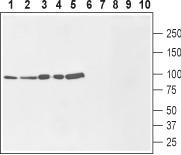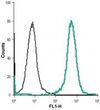Slc9a1 Rabbit Polyclonal Antibody
Other products for "Slc9a1"
Specifications
| Product Data | |
| Applications | FC, IF, WB |
| Recommended Dilution | WB: 1:200-1:2000; FC: 1:50-1:600 |
| Reactivities | Human, Mouse, Rat |
| Host | Rabbit |
| Clonality | Polyclonal |
| Immunogen | Peptide (C)RERSIGDVTTAPSE, corresponding to amino acid residues 54-67 of rat NHE-1 . 1st extracellular loop. |
| Formulation | Lyophilized. Concentration before lyophilization ~0.8mg/ml (lot dependent, please refer to CoA along with shipment for actual concentration). Buffer before lyophilization: Phosphate buffered saline (PBS), pH 7.4, 1% BSA, 0.05% NaN3. |
| Purification | Affinity purified on immobilized antigen. |
| Conjugation | Unconjugated |
| Storage | Store at -20°C as received. |
| Stability | Stable for 12 months from date of receipt. |
| Gene Name | solute carrier family 9 member A1 |
| Database Link | |
| Background | In order to function in optimal conditions, cells must maintain a close to neutral intracellular pH. They have adopted various mechanisms in order to do so, one of which is via Na+/H+Â exchangers (NHEs). Genes belonging to this group are expressed along a very broad range of organisms and are essential for protecting cells against intracellular acidification.To date, nine genes have been identified in mammals; NHE1-9. These membrane proteins have 10-12 transmembrane domains depending on whether a splice variant is expressed and an intracellular N-terminal. The C-terminal domain can be either intracellular or extracellular, also depending whether a splice variant of the protein is involved. The C-terminal part of the protein also undergoes posttranslational modification such as phosphorylation.Both NHE-1 and NHE-2 have an extracellular loop which is glycosylated.Under physiological conditions, the Na+/H+ exchanger mediates the exchange of one extracellular Na+ ion for one intracellular proton, thereby keeping the overall charge neutral1. The extracellular binding site of Na+ is not selective as it can also bind Li+ and H+ .K+ ions inhibit NHE-1 but have no effect on NHE-2.The activation of NHE-1 and NHE-2 is sensitive to intracellular acidic pH. Under physiological conditions, both exchangers are not active and upon a drop of intracellular pH, they are rapidly activated.NHE-1 expression is ubiquitous and may serve as a housekeeping gene. |
| Synonyms | APNH; APNH1; FLJ42224; NHE-1; NHE1 |
| Reference Data | |
Documents
| Product Manuals |
| FAQs |
{0} Product Review(s)
0 Product Review(s)
Submit review
Be the first one to submit a review
Product Citations
*Delivery time may vary from web posted schedule. Occasional delays may occur due to unforeseen
complexities in the preparation of your product. International customers may expect an additional 1-2 weeks
in shipping.






























































































































































































































































 Germany
Germany
 Japan
Japan
 United Kingdom
United Kingdom
 China
China





